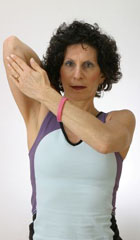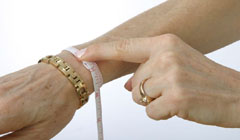EXERCISE:
WHEN AT LYMPHEDEMA RISK AFTER BREAST CANCER
By
Naomi Aaronson MA OTR/L CHT
This article is not intended to substitute for medical advice. Please
see your doctors, both surgeons and oncologists, and lymphedema
therapist before engaging in any exercise program.
See Our "Disclaimer" below before
beginning this or any exercise program.
Are you in a quandary over exercise? How many of you were warned not to lift more than 5-10 lbs. after breast cancer surgery and treatment? Or advised not to take up favored leisure pursuits such as golf and tennis that you once enjoyed? My guess is that many of you live in fear of developing lymphedema and were warned about the risks. Lymphedema is a real concern! That is why it is so important to "arm" yourself with the power of knowledge. There is good news!! A recent update from the National Lymphedema Network has
revised its guidelines for exercise. In addition, new research is
finding that exercise can benefit those of you at risk of developing
lymphedema.
You are considered to be at risk for lymphedema if you do not exhibit
any signs and symptoms of the condition but have a disruption in your
lymphatic system. Axillary lymph node removal and/or radiation are
considered risk factors because they cause a break down in lymphatic
flow. Other known risk factors include infection, obesity, and overuse.
The main concern regarding exercise is that exercise increases blood
flow. This can result in an increase in lymphatic load possibly leading
to lymphedema. It is difficult to predict who will develop this chronic
incurable condition. However, the benefits of exercise are profound to
the cardiovascular and musculoskeletal systems (heart, lungs, muscles,
and bones.) Avoiding it entirely, can be damaging to both mind and body.
That is why it is so important to be cautious and to educate yourself
thoroughly.
Here are some key points to know:
1) Be sure to obtain medical clearance before beginning any exercise
program, including clearance from your lymphedema therapist.
2) Use
deep breathing techniques
to minimize any pain and facilitate
lymphatic flow.
3) Wear a compression garment
(sleeve and
glove/gauntlet) that fit well
for the limb at risk when
exercising or performing necessary repetitive work such as vacuuming or
painting.
Always "promote" your lymph flow with manual lymph drainage
massage before donning any of your compression garments.
However, these garments are not required when swimming as the
water provides some compression!!
 4) Start with a gradual program of flexibility exercises to stretch the
pectoralis major/minor (where breast tissue is removed) and axillary
region (where lymph nodes are removed.) These areas may become tight due
to scar tissue and radiation and can block lymphatic flow. Yoga postures
such as child's pose and bow can help to stretch the area once you have
regained some flexibility. These stretches should be performed daily
once your physician/lymphedema therapist gives you clearance, and on a regular basis for the
rest of your life. That may seem to be an awesome task, but will help
you in the long run by preventing problems due to disuse and lack of
range of motion.
4) Start with a gradual program of flexibility exercises to stretch the
pectoralis major/minor (where breast tissue is removed) and axillary
region (where lymph nodes are removed.) These areas may become tight due
to scar tissue and radiation and can block lymphatic flow. Yoga postures
such as child's pose and bow can help to stretch the area once you have
regained some flexibility. These stretches should be performed daily
once your physician/lymphedema therapist gives you clearance, and on a regular basis for the
rest of your life. That may seem to be an awesome task, but will help
you in the long run by preventing problems due to disuse and lack of
range of motion.
5) Strength training should be undertaken in a gradual manner to the
effected arm. Muscular contractions can help to promote lymphatic flow.
However, too much too soon, without proper attention to form is not
safe. It is important to wear a
properly fitting sleeve/glove/gauntlet
especially for this type of
exercise, again remembering to "promote" your lymph flow with manual lymph drainage
massage before donning any of your compression garments. One should begin with light weights (1lb) or light bands
approximately 6 weeks after surgery. Do not wrap the band around your
arm or hand. It is best to start slowly with 8-12 repetitions to each
arm. You should alternate arms or take breaks between each set of 8-12
repetitions. Be sure to improve strength in your rotator cuff and back
for injury prevention. Do not increase the weights the same time you
increase the number of repetitions. Lift the weights slowly
and carefully and exhale on the effort. You may not feel any soreness if
your arm is numb, therefore it is important to monitor your arm for any
sign of swelling. If unsure of how to use weights, ask your physician
for a prescription for occupational therapy to ensure that you are doing
it properly.
 6) Learn how to take circumferential measurements (the width around your
arm) at your wrist, elbow, and knuckles minimally. Ask your lymphedema
therapist to show you how to do this accurately. Take baseline
measurements before you begin to exercise and on a regular basis. Know
what the signs and symptoms of lymphedema are.
6) Learn how to take circumferential measurements (the width around your
arm) at your wrist, elbow, and knuckles minimally. Ask your lymphedema
therapist to show you how to do this accurately. Take baseline
measurements before you begin to exercise and on a regular basis. Know
what the signs and symptoms of lymphedema are.
7) Aerobic exercise is exercise performed continuously for at least 20
minutes using the large muscles in the legs and arms which raises the
heart rate. This in turn improves cardiovascular fitness, but may
increase the lymphatic flow as blood flow increases. By improving this
system, ones overall health is maximized. Swimming is especially
beneficial, as there is no jolt as one moves in the water making it
easier on the joints . In addition, the coolness and hydrostatic
pressure of the water facilitates lymphatic flow. Swimming, bicycling,
jogging, step aerobics, and walking are all considered to be aerobic. A
sleeve should be worn for all activities except for swimming. Start
slowly and gradually increase the duration (length of time you exercise)
and frequency (number of sessions per week that you exercise.)
8) If exercising outdoors, exercise when it is cooler and be sure to
wear sunscreen.
Taking a careful approach to exercise can get you back into the swing of
things!! Hopefully, you will be able to take part in the activities that
you once enjoyed and even learn some new ones!!
References:
Burt, J and White, G Lymphedema 2006 Hunter House Publishers
Harris, S , Hugi, M.
Clinical
Practice guidelines for the care and treatment of breast cancer:
11.
Lymphedema 2001 Canadian Medical Association.
See also:
Disclaimer:
This article or the links to exercises above are not intended to substitute for medical advice. Please
see your doctors and lymphedema therapist before engaging in any exercise program.
Each of us is an individual whose base fitness level before
breast cancer could have been anywhere between a lovely,
comfortable, overweight couch potato or a marathon runner, a
triathlon participant, or in any range of many fitness levels
between.
We
also range from very young to very old, and often have significant
medical problems still remaining from our cancer surgery,
chemotherapy, radiation therapy and hormonal therapy.
And many of us have had reconstructive surgeries of various types
which will also change how quickly and how much of particular
exercises we can do.
Please make sure to discuss your former fitness level and past
treatments with your doctor and lymphedema therapist before
proceeding with any exercise program.
While exercise is absolutely essential in regaining your range of
motion, and increasing your lymphatic flow, too much too soon, when
your individual body is not ready for it and without proper
guidance, is not safe.
We
cannot take any responsibility for any injuries caused if you
have not followed this advice and consulted with your physicians and
lymphedema therapist before starting any exercise program.

Page Last Modified
09/29/2015
All
medical information presented on this page is the opinion of
our Editorial Board and Experts. See our "About
us"
and "Resources"
pages.



